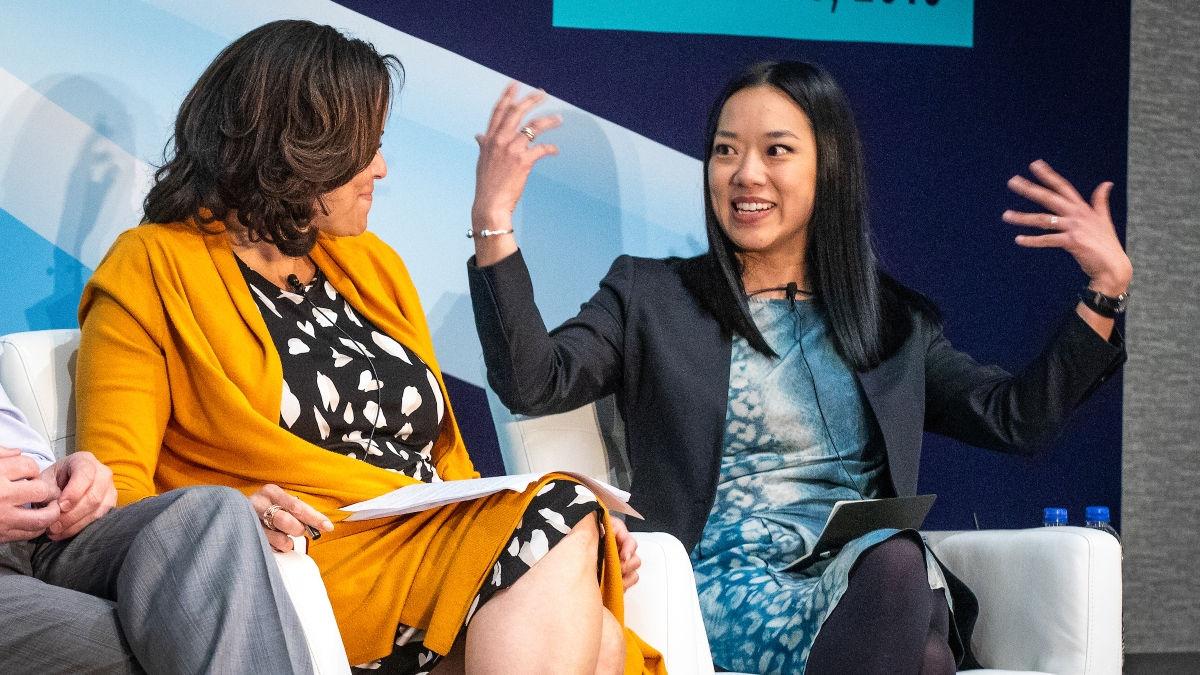Innovating to help students transition to the workplace

Grace O'Sullivan, ASU assistant vice president for corporate engagement and strategic partnerships (right), talks with fellow panelist Nicole Taylor, deputy vice president and dean of students at ASU, during the "Workforce Transition Innovations — Reimagining Career Services" event at the ASU+GSV Summit 2018 in San Diego on Tuesday. Also on the panel was Paul LePore, associate dean in ASU's College of Liberal Arts and Sciences; and Cindy Parnell, executive director of Career and Professional Development Services at ASU, was the moderator. Photo by Charlie Leight/ASU Now
Editor's note: Read more of the highlights from the ASU + GSV Summit on our blog.
Arizona State University has changed its role in preparing graduates for the workforce beyond the traditional work of a career services office. At the ASU + GSV Summit, ASU leaders discussed how they positioned the university at the forefront of workforce transition innovations.
Cindy Parnell, executive director, career and professional development services: In the last decade, career services has undergone steep disruption around the return on investment of a college degree. The old model of career centers being a physical place where a student has to walk through the doors to receive services and support typically from a master’s level professional in one hour is long gone. Now career services is starting to integrate across the ecosystem to foster those career-readiness skills. We call it more of a presence than a place.
Nicole Taylor, deputy vice president and dean of students: In 1980, 80 percent of the undergraduate pop was white. At ASU 50 percent of our first-time students right now are not white. That’s the given. As we think about how we’re educating, if we start at that alone, it changes the game. Our institutions are structured in a way that catered to students in the 1980s.
The helicopter parent isn’t going away. I have more parents who reach out to me than students. It’s a given. We have to deal with parents and family members as well as students.
The other is coping skills. The transition to postsecondary education is dramatic anyway. It is hyper-dramatic for our current college students. We have seen a 92 percent increase in counseling appointments over five years ago. Then you add things like DACA. That all changes how we’re preparing this generation of students for work.
We’ve taken an approach at ASU that all of the preparation doesn’t happen in career services. It happens in the colleges, the counseling center, anyone who is student-facing takes the responsibility across the university.
Grace O’Sullivan, assistant vice president, corporate engagement and strategic partnerships: Our industry participants aren’t just at the end of the pipeline catching talent. They come along for the entire journey. We’re engaged from site selection to talent, upscaling their current workforce to philanthropy. We say, "What do you need? What’s missing from our curriculum? Join our dean’s council. Teach a class. Help us build the skills. We need you to keep us relevant."
This model we’re launching is called practice labs. Think of this as problem-based learning where you’re in an environment where you can test the skills. One of our partners, Starbucks, has a technology center practice lab. They hired full-time employees to be embedded with us on campus. For them the internship is an interview.
Paul LePore, associate dean, College of Liberal Arts & Sciences: It’s probably not a shock that the question I get from a lot of parents is, "What will my son or daughter do with this degree?"
We need to be thinking of career readiness not as an evil intrusion into the arts and sciences. We need to have career readiness as part of the undergraduate experience. We also need to curate the experience on the employer side.
We didn’t want to call it a career center so we are creating a “future center.” Many of our students go to grad school. They go to professional training. We need to work carefully with a company so they feel the partnership is two-sided. I have students, I have families, I have faculty, I have alumni, I have business partners in the community, and they all have a role in this.